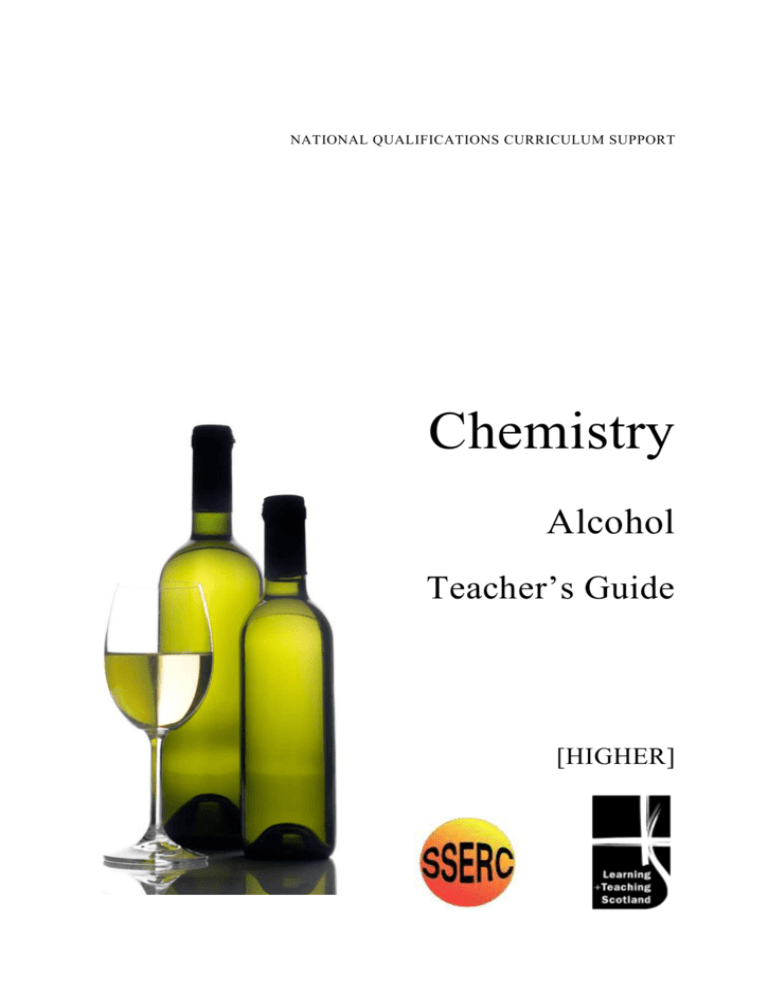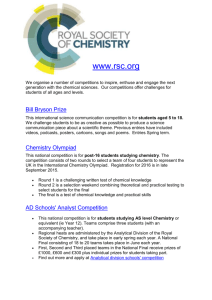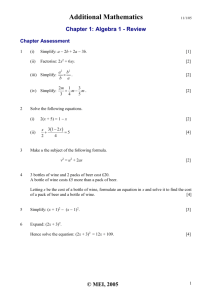Investigating Alcohol - Teacher`s Guide
advertisement

NATIONAL QUALIFICATIONS CURRICULUM SUPPORT Chemistry Alcohol Teacher’s Guide [HIGHER] The Scottish Qualifications Authority regularly reviews the arrangements for National Qualifications. Users of all NQ support materials, whether published by Learning and Teaching Scotland or others, are reminded that it is their responsibility to check that the support materials correspond to the requirements of the current arrangements. Acknowledgement Learning and Teaching Scotland gratefully acknowledges this contribution to the National Qualifications support programme for Chemistry. © Learning and Teaching Scotland 2011 This resource may be reproduced in whole or in part for educational purposes by educational establishments in Scotland provided that no profit accrues at any stage. 2 RESEARCHING CHEMISTRY: ALCOHOL (H, CHEMISTRY) © Learning and Teaching Scotland 2011 Contents Introduction 4 Why is this topical? 4 Teaching notes for the investigations 7 Technician notes for the investigations 11 SSERC risk assessment 14 RESEARCHING CHEMISTRY: ALCOHOL (H, CHEMISTRY) © Learning and Teaching Scotland 2011 3 TEACHER’S NOTES Introduction The Alcohol support pack for the Researching Chemistry unit contains a selection of five possible investigations, labelled A to E. Investigation Title A Do alcopops make you fat? How much sugar is in an alcopop? B How many units of alcohol are really in a glass of white wine? C How does the SO 2 concentration in wine compare with that in cider? D Do white wines from different countries have different SO 2 concentrations? E How does the concentration of SO 2 in a dry white wine compare with that in a sweet white wine? Teachers should feel free to edit these investigations to suit the needs of their own students. For example, some teachers may wish to remove some of the experimental instructions from the student guides to make the planning process more challenging for able students. Additionally, the list of investigations is by no means exhaustive; teachers are free to develop their own alternative investigation topics to enhance the experience for students. Why is this topical? Alcohol has been used and abused for centuries. However, it has become a hot political topic in Scotland (2010) with cries for higher prices, lower percentage alcohol content and crackdowns on under-age drinking. The chemist’s role in investigating this topic is one of quality control: how do we find out how much ethanol/sulphite/sugar is in an alcoholic beverage? Without this information, we cannot pass laws or monitor what companies are producing. 4 RESEARCHING CHEMISTRY: ALCOHOL (H, CHEMISTRY) © Learning and Teaching Scotland 2011 TEACHER’S NOTES Sulphites are added as preservatives to alcoholic drinks. However, they have received recent negative media attention due to reports that they can cause serious allergic reactions. Many people claim that they cannot drink wine or cider because the added sulphur dioxide initiates an asthma attack . Media attention on this has prompted drinks makers to create alcoholic drinks that are allegedly sulphite free. Alcopops have also been the centre of recent media attention due to concerns that manufacturers are marketing these drinks specifically at younger drinkers. Adding sugar or using attractive colours or brightly coloured labels are just some of the techniques allegedly used to attract a younger generation of drinker. As a general introduction to the problems of alcohol in society, the following video clips could be used to stimulate discussion. The specific links about sulphites and sugar in alcopops should also be used to introduce the se particular investigations. Media items 1. Binge drinking boy education advert http://www.youtube.com/watch?v=EuowE1SXNkA&feature=related 2. Alcohol news item on alcohol abuse in Scotland http://www.youtube.com/watch?v=TLJkTjvp -9g 3. Scheme in England to cut strength of alcoholic drinks http://news.bbc.co.uk/player/nol/newsid_7260000/newsid_7263200/726 3275.stm?bw=bb&mp=wm&news=1&ms3=6&ms_javascript=true&nol_ storyid=7263275&bbcws=2 4. Cider maker to cut alcohol level http://news.bbc.co.uk/1/hi/england/hereford/worcs/7952713.stm http://news.bbc.co.uk/1/hi/scotland/3650248.stm 5. Buckfast ban? http://news.bbc.co.uk/1/hi/scotland/10164507.stm RESEARCHING CHEMISTRY: ALCOHOL (H, CHEMISTRY) © Learning and Teaching Scotland 2011 5 TEACHER’S NOTES Sulphur dioxide in wine 1. Link to allergies http://news.bbc.co.uk/1/hi/health/6348001.stm 2. Sulphites as preservatives in foods and drinks http://www.youtube.com/watch?v=XYKJyEqYCEU&feature=related 3. Do sulphites cause headaches? http://www.youtube.com/watch?v=7VnxoOOHVag&feature=related Alcopops and sugar 1. Various websites on alcopops/binge drinking. http://search.bbc.co.uk/search?q=alcopops&tab=av&uri=%2F&go=toolb ar&scope=all 2. Daily Mail news articles on alcopops http://www.dailymail.co.uk/home/search.html?pageOffset=&pageSize= &orderBy=relevDesc&searchPhrase=alcopops&dateupd ated=&dateFro m=&dateTo= 3. Alcopops ad http://cspinet.org/alcopops/AlcopopAd.pdf 6 RESEARCHING CHEMISTRY: ALCOHOL (H, CHEMISTRY) © Learning and Teaching Scotland 2011 TEACHER’S NOTES Teaching notes for the investigations Investigation A: Do alcopops make you fat? How much sugar is in an alcopop? Students determine the sugar content of alcopops by: (i) (ii) (iii) preparing standard sugar solutions and measuring their density constructing a calibration graph of density versus sugar concentration measuring the density of an alcopop by weighing a fixed volume of the drink – this density is then used to calculate the sugar content by comparing it with the calibration graph. In order to obtain reliable results, the alcopop should not contain a large number of other substances (apart from sugar) that could significantly affect the density of the drink. In trials Bacardi Breezers produced fairly accurate results, but slightly more viscous drinks (such as Blue WKD) did not produce accurate results. Some brands state the sugar content on the ingredients label. Again, it would seem sensible to ‘hide’ this from students to give them a greater sense of satisfaction as they solve the problem. The method has been adapted from a technique used to determine the sugar content of soft drinks: http://ares.unimet.edu.ve/quimica/fbqi01/Labqui/p1122.pdf Investigation B: How many units of alcohol are really in a glass of white wine? This investigation requires students to measure the density of an alcoholic drink and to use this value to determine the percentage of ethanol in a drink by comparison to a calibration graph that they have previously constructed. If time is an issue, it would be worth splitting this investigation between team members into two parts, with one half of the team tackling the construction of the calibration graph whilst the other half of the team determines the density of the wine. The density of a liquid is calculated by dividing the mass of the liquid by its volume. Water has a higher density than ethanol. As alcoholic drinks contain ethanol and water, the density of the drink is somewhere in between that of pure ethanol and pure water. By making up standard solutions of ethanol and determining the density of these solutions, the percentage of ethanol in a sample of wine can be determined. RESEARCHING CHEMISTRY: ALCOHOL (H, CHEMISTRY) © Learning and Teaching Scotland 2011 7 TEACHER’S NOTES When constructing a calibration graph, students could plot their results using an Excel spreadsheet so that they can quickly check their graph and re -make any standard solutions that produce results which lie outside the best -fit line. If time is available, students should be encouraged to repeat their experiments to ensure reproducibility. Apart from ethanol, wine contains many other substances that affect its density. Thus, in order for this investigation to work effectively, students must first distil the wine to ensure that the sample being analysed is only made of ethanol and water. Additionally, the wine needs to be made alkaline prior to distillation. This ensures that any volatile acids present are converted to non-volatile salts, to prevent carry over during distillation and to ensure the density is not affected. Students place 50 ml of wine into a round-bottomed flask along with 2 mol l –1 of sodium hydroxide solution. The wine is then distilled until 25 ml of distillate is collected. The mass of the 25 ml of distillate is then calculated. The density is calculated by dividing this mass by the volume (25 ml). The density is then converted into the percentage alcohol by reading from the calibration curve. If the white wine is fizzy, it will require de-gassing prior to the start of the experiment. This can be achieved by simply swirling a sample of the wine in an open conical flask. Most wines have percentage ethanol content displayed on the label. Teachers/lecturers may wish to ‘hide’ this information from students to allow a greater sense of satisfaction from working out the value. The following A-level chemistry website provides lots of useful guidance for both students and teachers on this topic: http://www.chemistryreact.org/go/search/SearchResults.html?action=SearchActions& action_search =search&search_scope=1&search_query=wine Investigations C, D and E: Determination of SO 2 content in alcoholic drinks Sulphur dioxide is used to preserve many alcoholic drinks. It has been used for centuries and helps to stop drinks from spo iling. Drinks makers refer to the sulphur compounds added to drinks as sulphites. Sulphites include all the sulphur compounds that help to preserve the drink. Recently, however, 8 RESEARCHING CHEMISTRY: ALCOHOL (H, CHEMISTRY) © Learning and Teaching Scotland 2011 TEACHER’S NOTES concern has been expressed that sulphites in wine can have undesirable health effects. As a result, many drinks manufacturers are working on methods to reduce the concentration of sulphites added. There are also laws which limit the amount of sulphites that can be added to wine. Consequently, chemists need to be able to use methods to calculate the concentration of sulphites accurately so that they know that the drink will be kept fresh for a reasonable time, that it will not taste foul as a result of using too much preservative and that the concentration of sulphites is within legal limits. The students’ task in this investigation is to find out the SO 2 concentration in a wine and a cider. They will do this by converting all the sulphites to SO 2 . They can then compare the concentration they have found with the legal limits for Europe. Chemists refer to two types of sulphur dioxide: (i) (ii) free SO 2 , eg SO 2 , H 2 SO 3 , HSO 3 – and SO 3 2– combined SO 2 , which is joined to aldehydes, ketones and phenolic derivatives. Total SO 2 = free SO 2 + combined SO 2 Combined SO 2 has no antimicrobial activity, whereas free SO 2 does, making it crucial that wine-makers can determine the concentration of both types. In these investigations, however, students will only determine total SO 2 concentration. The SO 2 content is determined via the following redox titration, using starch as indicator: SO 2 (aq) + I 2 (aq) + 2H 2 O (l) → 4H + (aq) + SO 4 2– (aq) + 2I – (aq) If a standard iodine solution is added to a sample of wine, the iodine will react with the SO 2 . When all of the SO 2 has reacted, the iodine will react with the starch to give a blue–black colour, indicating the end-point. The concentration of SO 2 can be calculated since 1 mole of iodine reacts with 1 mole of SO 2 . Most countries express SO 2 concentration in wine in units of ppm (parts per million). Units of ppm are exactly equivalent to units of mg l –1 . RESEARCHING CHEMISTRY: ALCOHOL (H, CHEMISTRY) © Learning and Teaching Scotland 2011 9 TEACHER’S NOTES If a student calculates that there are 0.00025 moles SO 2 in a 50 ml sample of wine: Mass of SO 2 = moles × formula mass = 0.00025 × 64 = 0.016 g ie there are 0.016 g of SO 2 per 50 ml of wine = 0.016 × 20 = 0.32 g of SO 2 per 1000 ml of wine 0.32 g = 0.32 ×1000 = 320 mg of SO 2 So, the SO 2 concentration in the wine sample is 320 mg l –1 = 320 ppm Different countries have set different limits for the SO 2 concentration. Generally, the limits are between 200 and 400 ppm. Useful additional reading 1. http://www.morethanorganic.com/sulphur-in-the-bottle 2. http://www.chemistryreact.org/go/search/SearchResults.html?action=SearchActions&action_s earch=search&search_scope=1&search_query=wine 10 RESEARCHING CHEMISTRY: ALCOHOL (H, CHEMISTRY) © Learning and Teaching Scotland 2011 TEACHER’S NOTES Technician notes for the investigations Investigation A: Do alcopops make you fat? How much sugar is in an alcopop? Requirements (per group) Chemicals Apparatus 1 bottle of sucrose (500 grams) 1 accurate balance Bottles of alcopops, eg Bacardi Breezers 1 × 500-ml standard flask Deionised water 8 × 50-ml standard flasks 1 bottle of ethanol (100 ml) 25-ml pipette Pipette fillers Pipettes available to measure 35 ml (or use a burette) Investigation B: How many units of alcohol are really in a glass of white wine? Requirements (per group) Chemicals Apparatus 1 bottle of ethanol (200 ml) 6 × 100-ml standard flasks Deionised water 1 × 50-ml standard flask 1 bottle of 2 mol l ml) –1 NaOH (aq) (250 Accurate balance 2 bottles of white wine Graduated pipettes to allow measurement of 8–20 ml (alternatively, use a burette) 1 jar of boiling chips Pipette fillers 50-ml pipette 100-ml round-bottomed flask with Quickfit attachments to perform a distillation (include thermometer) 1 heating mantle RESEARCHING CHEMISTRY: ALCOHOL (H, CHEMISTRY) © Learning and Teaching Scotland 2011 11 TEACHER’S NOTES Investigation C: How does the SO 2 concentration in wine compare with that in cider? Requirements (per group) Chemicals Apparatus 1 bottle of white wine 2 × 25-ml pipettes 1 bottle of cider 2 × 250-ml conical flasks Deionised water White tiles 2 mol l –1 sulphuric acid (aq) (250 ml) 2 burettes and stands 1 mol l ml) –1 sodium hydroxide (aq) (250 Pipette fillers 1 bottle of starch solution (1%) 1 bottle of standard iodine (aq) 0.001 mol l –1 (500 ml) *Only required if doing extension* 1 bottle of standard iodine (aq) 0.005 mol l –1 (500 ml) 1 bottle of dilute sodium thiosulphate Investigation D: Do white wines from different countries have different SO 2 concentrations? Requirements (per group) Chemicals Apparatus 1 bottle of white wine A 2 × 25-ml pipettes 1 bottle of white wine B 2 × 250-ml conical flasks Deionised water White tiles 2 mol l –1 sulphuric acid (aq) (250 ml) 2 burettes and stands 1 mol l –1 sodium hydroxide (aq) (250 ml) 1 bottle of starch solution (1%) Pipette fillers 1 bottle of standard iodine (aq) 0.001 mol l –1 (500 ml) 1 bottle of standard iodine (aq) 0.005 mol l –1 (500 ml) 12 RESEARCHING CHEMISTRY: ALCOHOL (H, CHEMISTRY) © Learning and Teaching Scotland 2011 TEACHER’S NOTES Investigation E: How does the concentration of SO 2 in a dry white wine compare with that in a sweet white wine? Requirements (per group) Chemicals Apparatus 1 bottle of white wine A (dry) 2 × 25 ml pipettes 1 bottle of white wine B (sweet) 2 × 250 ml conical flask Deionised water White tiles 2 mol l –1 sulphuric acid (aq) (250 ml) 2 burettes and stands 1 mol l ml) –1 sodium hydroxide (aq) (250 Pipette fillers 1 bottle of starch solution (1%) 1 bottle of standard iodine (aq) 0.001 mol l –1 (500 ml) 1 bottle of standard iodine (aq) 0.005 mol l –1 (500 ml) RESEARCHING CHEMISTRY: ALCOHOL (H, CHEMISTRY) © Learning and Teaching Scotland 2011 13 TEACHER’S NOTES SSERC risk assessment (revised version November 2009) (based on HSE 5 steps to risk assessment) 2 Pitreavie Court, South Pitreavie Business Park, Dunfermline KY11 8UB tel: 01383 626070 fax : 01383 842793 e-mail: sts@sserc.org.uk web: www.sserc.org.uk Activity assessed Alcohol investigation for Higher Chemistry Date of assessment 1 July 2010 Date of review (Step 5) School Department 14 RESEARCHING CHEMISTRY: ALCOHOL (H, CHEMISTRY) © Learning and Teaching Scotland 2011 TEACHER’S NOTES Step 1 List significant hazards here Step 2 Who might be harmed and how? Step 3 What are you already doing? Technician, teacher and students See SSERC Hazardous Chemicals Wear indirect vent goggles (BS EN 1663) What further action is needed? Step 4 Action by whom? Action by when? Investigation B Ethanol Highly flammable If spilled on skin, wash off with copious amounts of water Keep away from naked flames Use a heating mantle to heat the alcoholic solution Add a boiling chip to the round-bottomed flask to prevent bumping of the mixture RESEARCHING CHEMISTRY: ALCOHOL (H, CHEMISTRY) © Learning and Teaching Scotland 2011 15 Done TEACHER’S NOTES Step 1 NaOH (aq) 2 mol l –1 Corrosive 16 Step 2 Technician (extra care must be taken if preparing from solid NaOH), teacher and students Step 3 Rubber gloves should be worn by the technician if handling the solid Wear indirect vent goggles (BS EN 1663) If spilled on skin, wash off with copious amounts of water RESEARCHING CHEMISTRY: ALCOHOL (H, CHEMISTRY) © Learning and Teaching Scotland 2011 Step 4 TEACHER’S NOTES Investigations C, D and E Starch (no significant hazard) NaOH (aq) 1 mol l –1 Corrosive Technician, teacher by inhalation Avoid breathing in any dust Wear indirect vent goggles (BS EN 1663) Technician (extra care must be taken if preparing from solid NaOH), teacher and students Rubber gloves should be worn by the technician if handling the solid Wear indirect vent goggles (BS EN 1663) If spilled on skin, wash off with copious amounts of water Sulphuric acid 2 mol l –1 Corrosive Technician (extra care must be taken if preparing from concentrated sulphuric acid), teacher and students Rubber gloves should be worn by the technician if handling concentrated sulphuric acid Wear indirect vent goggles (BS EN 1663) If spilled on skin, wash off with copious amounts of water RESEARCHING CHEMISTRY: ALCOHOL (H, CHEMISTRY) © Learning and Teaching Scotland 2011 17 TEACHER’S NOTES Iodine solution (0.005 and 0.001 mol l –1 ) Harmful and dangerous for the environment Technician, teacher and students Investigation A Sucrose (no significant hazard) Teacher, technician and students: avoid raising a dust Wear indirect vent goggles (BS EN 1663) If spilled on skin, wash off with copious amounts of water Description of activity Investigation A Determining the sucrose concentration of alcopops. Investigation B Determining the ethanol content of wine. Preparing standard ethanol solutions and preparing wine samples by adding NaOH (aq) and distilling. Investigations C, D and E Determining the concentration of SO 2 in wines/ciders by titration with iodine. 18 RESEARCHING CHEMISTRY: ALCOHOL (H, CHEMISTRY) © Learning and Teaching Scotland 2011






